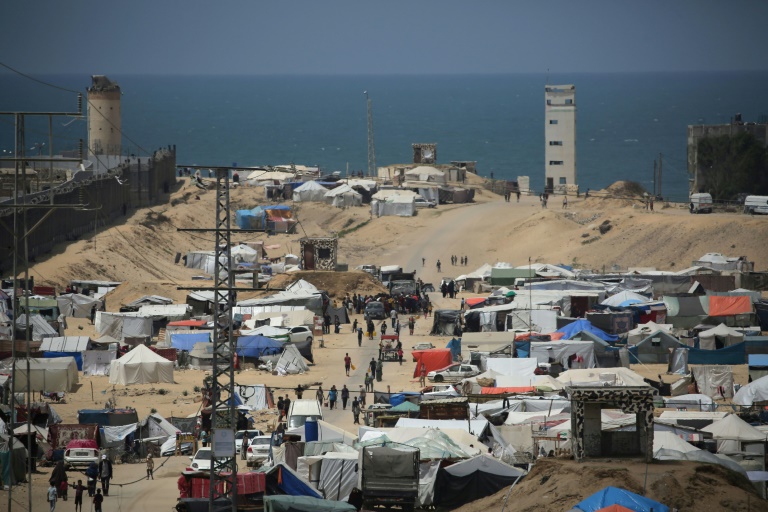Gazans struggle with heat, garbage, insect swarms

A camp for displaced people in Rafah in the southern Gaza Strip by the border with Egypt on April 28, 2024, amid the ongoing conflict between Israel and Hamas
Rafah – As garbage piles up and the heat rises in war-torn Gaza, flies and mosquitoes proliferate in crowded Rafah city and life becomes even more grim for displaced people living in tents.
Last week, temperatures already topped 30 degrees Celsius (86 degrees Fahrenheit), turning the makeshift shelters made from plastic tarps and sheets into sweltering ovens.
On a sliver of land on the outskirts of the far-southern city on the Egyptian border, about 20 of these tents have been erected, all shaded by a large sheet stretched above them.
But the thin, dark cloth is no match for the blazing sun that has sent temperatures rising fast in late April, making it harder to preserve scarce potable water and food.
“The water we drink is warm,” Ranine Aouni al-Arian, a Palestinian woman displaced from the devastated nearby city of Khan Yunis, told AFP.
“The children can’t bear the heat and the mosquito and fly bites anymore,” she told AFP.
She was holding a baby whose face was covered in insect bites and said that she struggles to find “a treatment or a solution”.
Around her, swarms of flies and other insects were buzzing incessantly.
“It’s the first time we see so many, because of the pollution and the waste discarded everywhere”, said Aala Saleh, from Jabalia in the north of Gaza.
He said sleeping has become nearly impossible inside his tent, “because we wake up from the mosquito bites, and our main concern is to kill these insects”.
Amid the heat and unsanitary conditions, he said he worried about “the spread of disease”.
– ‘Living in hell’ –
The World Health Organization warned in January of a leap in infectious diseases such as hepatitis A, blamed on unsanitary conditions in camps.
“Waste continues piling up & running water is scarce” in Gaza, warned UNRWA, the United Nations agency for Palestinian refugees, in a post on X last week.
“As the weather gets warmer, the risk of disease spreading increases.”
Rafah hosts about 1.5 million displaced, according to the UN, more than half of the Gaza Strip’s population which has been besieged and bombarded by Israel for nearly seven months.
On the streets, garbage accumulates as large rubbish containers overflow after basic services broke down long ago amid Gaza’s worst ever war.
The Israeli army has relentlessly pounded the small Palestinian territory in response to the unprecedented attack by Hamas on October 7, which resulted in the deaths of 1,170 people, mostly civilians, according to an AFP tally based on official Israeli figures.
Israel’s military operation has killed at least 34,488 people in Gaza, mostly women and children, according to the health ministry in the Hamas-run territory.
The war has also destroyed “waste collection vehicles, facilities and medical waste treatment centres”, leaving “municipalities scrambling to cope with the escalating crisis”, a UN report said late last month.
“We’re living in hell,” said Hanane Saber, a 41-year-old displaced Palestinian whose children can no longer bear the steamy tent.
“I’m exhausted from the heat, on top of mosquitoes and flies everywhere that bother us day and night,” she said, her voice barely audible above the sound of Israeli drones and planes.
Daily tasks such as “cooking and cleaning” or preparing bread dough “are conducted inside the tent in stifling heat”, said Mervat Alian, a displaced woman from Gaza City.
“It’s as if we were living in a grave, life doesn’t exist anymore.”
